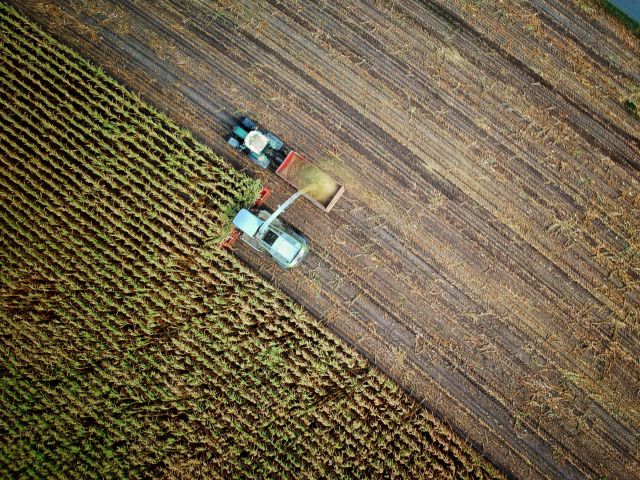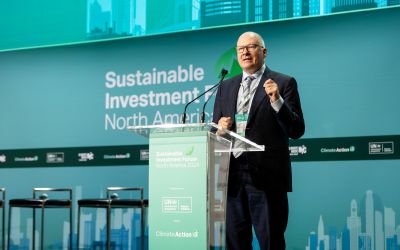Springfield Agri on the importance of making markets more accessible to farmers
Ahead of the Sustainable Innovation Forum 2021, Climate Action caught up with Springfield Agri, to discuss why it is important to make markets more accessible to farmers and farming cooperatives.

Ahead of the Sustainable Innovation Forum 2021, Climate Action caught up with Springfield Agri to discuss why it is important to make markets more accessible to farmers and farming cooperatives.
How do we create unimpeachable metrics on a real-time basis to provide the confidence that Impact funders need to move into this space?
Answering this question requires a full system approach with full connectivity to the cloud. To create unimpeachable metrics requires the combination of sensors remotely connected digitally to a cloud based system combined with connectivity to satellite data. By using algorithms to convert data collected from multiple sensors we can calculate metrics such as carbon content. We also use above and below biometric sensors to determine biodiversity which is a good indication of soil health. The count of worms is especially a good indication of the increased carbon and microbial activity. We can also measure attributes such as pollution in the area and nitrous oxide and methane emissions from the soil. Through the increase in soil health the quality and quantity of naturally produced product will increase and the farmer will have detailed data to reduce inputs and increase productivity. As we are digitally collecting from a full sensory approach this will provide confidence in the reporting of outcomes from soil health to biodiversity. The results are independent of manual input and collected regularly of a daily basis and would therefore be extremely hard to falsify.
How do farmers and landowners access funds or working capital to enable the journey to better farming practices, regardless of the size of the farm?
Successfully accessing capital begins with education in the areas of both regenerative agriculture and operational business. The farmer – big or small -- must have the information needed to design an agricultural transition plan guided by globally accepted standards for regenerative agricultural practices as well as develop a business case that includes a viable financial model. Finally, they need training to utilize the technical know-how necessary for an environmentally successful farming operation.
From a capital provider’s perspective, operational transparency is established through an independent pre-qualification of a farmer’s agricultural transition plan, the introduction of new regenerative technologies to help implement their plan, and post-funding continuous monitoring to assure compliance with that plan. The resulting immutable data set that is produced profiles transactional economics critical to investor confidence and incremental progress toward healthier soils critical to broader stakeholder engagement. Access to results-based data evidencing actual outcomes “in the field” encourages institutional investor support for large-scale capital programs in the agricultural sector.
The engagement of stakeholders that have a vested interest in the broad adoption of regenerative agricultural practices directly lends itself to the establishment and maintenance of dedicated capital pools aimed expressly at meeting the unique needs of farms-in-transition. This programmatic approach democratizes access to capital in the agricultural sector for almost any farmer working diligently toward improved soil health with a view to driving improved crop yields, premium commodity pricing, and enhanced operating margins.
How do we shorten the supply chain and make markets more accessible to farmers and farming cooperatives?
The agriculture industry, inclusive of the 570 million small farms (smallholders) representing 90% of the worlds farms, is on the verge of a massive paradigm shift driven by:
1. The cycle of centralization to decentralization where large scale efficiencies face smallholder impact.
2. Growing consumer demand to know the origins, content and delivery process that impact their food.
3. Increasing data and measurement tools driven by technology and resulting in consumer information, risk management opportunities, increased efficiencies and impact to global ecosystems.
Transparency increases trust. The largest producers, driven by quarterly shareholder profit requirements, have the greatest influence on the supply chain resulting in unintended consequences that must be addressed. The complexities and vulnerabilities of the global agricultural supply chain will be well served, as will the environment at large, through the following benefits of Blockchain adoption:
1. Relationship: The smallholder regains status as the valuable source of the desired product. The consumer is more connected with the farmer and can track the origins, journey and delivery of agricultural resources.
2. Remuneration: The smallholder can go direct to market, reducing the multiple levels of handlers and agents that currently receive 80% of the financial benefits.
3. Real-time: Transactions are expedited, farmers can set their own prices and consumers can participate in risk and financing.
4. Recourses: The transition from an agrarian based society has not impacted our dependency on agriculture. A modern society equipped with the tools of “go fund me”, social media and electronic marketplaces can provide direct support to the smallholder that sits on the front line of global environmental impact.
A profound opportunity exists for the 2030 Sustainable Development Goals to be realized through leveraging leading-edge technology integrated with the proven benefits of blockchain technology. Adoption of such a system provides an equitable solution to the smallholder that has been ignored but, when properly empowered, can be a valuable force multiplier for a positive impact on the challenges of climate change.
India has massive issues in feeding itself, how can these be overcome and at the same time lessen climate change impact and loss of biodiversity and improve farmers and rural communities’ lives?
Currently, India is at 50% productivity as far as agricultural output is concerned. We have slipped to #101 of hungriest nations and we are a long way off from our climate goals. Farm quality is also a major concern when it comes to looking at the rural ecosystem’s welfare both in financial and sustainable terms. Yet, all of these problems are solvable. The government has set a bold goal to double average farmer wages. They are committed to radical systemic change to improve output and quality and they are looking at partnerships to help them do it. To increase food production, new alliances will have to be made and indeed they already are. Investors, government, tech, and agri experts along with major corporations are piloting schemes which look at everything across the spectrum from the health of the soil where it all begins, to the growing and rotation of crops, to storage and to distribution. This is already happening, however the key to success will be the scaling of these practices. There are currently 120 million plus small farm holdings in India, impacting 1million is not good enough, we have to impact at least 30% in one year or the real effects on the goals will not be met.
As we move to better and more data driven farming practices we will be able to look more effectively at biodiversity. As in all countries, farmers are no longer just about producing materials and food, and they are now the guardians of the environment and the climate at the same time. This is a huge burden and they cannot be expected to succeed without significant help. In summary, to increase production, increase biodiversity, increase sustainable practices, and to better the rural communities’ life, a huge amount of focus, effort, and scale will have to be embarked upon. The first and most important step will be: to listen, to understand what the issues and barriers are, and from that to adopt the right existing solutions and scale them quickly with the right partners. Sounds simple? Maybe not, but we have no choice but to succeed.
Why is a systems-based approach requiring healthy soils that can be delivered at scale and pace if we are going to be successful in mitigating climate change from a soils base?
Soil can only be properly understood as a complex biophysical system, where health emerges spontaneously out of billions of interactions between microbes and a dynamical physical architecture. Soil health is connected with a system of co-benefits including water and food security, carbon sequestration and emissions reduction. While health emerges from microscale processes, it can be restored through crop, nutrient and tillage management. Diets that are healthier also promote the health of soil because they require greater diversity of crops grown in a rotation with pasture-based livestock. Therefore, soil health is part of a wider system, or value network, linking consumption to production. Finally, since land-clearing for agriculture is the dominant factor in the decline of global biodiversity, restoring soil health reduces the demand on land and hence helps restore biodiversity.
Taken all together, the maximum impact on soil health can only be achieved when we think of it as part of a multiscale system from micrometre sized particles to integrated land management and consumer choices. The number of different and interacting factors impacting on soil health precludes the standard randomised control trials that are normally used in science to determine the optimal intervention. A systems approach necessitates a new relationship between scientists, farmers and policy, where farmers become citizen scientists in the living laboratory that is their farms.
Springfield Agri are speaking at the Sustainable Innovation Forum 2021, to join them register here now.






